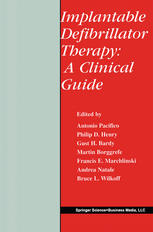

Most ebook files are in PDF format, so you can easily read them using various software such as Foxit Reader or directly on the Google Chrome browser.
Some ebook files are released by publishers in other formats such as .awz, .mobi, .epub, .fb2, etc. You may need to install specific software to read these formats on mobile/PC, such as Calibre.
Please read the tutorial at this link: https://ebookbell.com/faq
We offer FREE conversion to the popular formats you request; however, this may take some time. Therefore, right after payment, please email us, and we will try to provide the service as quickly as possible.
For some exceptional file formats or broken links (if any), please refrain from opening any disputes. Instead, email us first, and we will try to assist within a maximum of 6 hours.
EbookBell Team

5.0
68 reviewsImplantable defibrillators as originally conceived by Michel Mirowski were limited to the detection and automatic termination of ventricular fibrillation. In the original "AID" device, the detection algoritlun sought to distinguish sinus rhytlun from ventricular fibrillation by identifying the "more sinusoidal waveform of ventricular fibrillation. " The therapeutic intervention was elicited only once deadly polymorphic rhythms had developed. It was rapidly learned, however, that ventricular fibrillation is usually preceded by ventricular tachycardia. Mirowski recognized the pivotal importance of developing algoritllms based on heart rate. Ventricular tachycardia detection allowed the successful development of interventions for the termination of ventricular tachyarrhythmias before they degenerated into ventricular fibrillation. Current device therapy no longer confines itself to tlle termination of chaotic rhythms but seeks to prevent them. Diagnostic algorithms moved upward along the chain of events leading to catastrophic rhytlulls. Rate smoothing algorithms were developed to prevent postextrasystolic pauses from triggering ventricular and atrial tachyarrhytlmlias. Beyond the renaissance of ectopy-centered strategies, long-term prevention received increasing attention. Multisite pacing therapies provided by "Arrhythmia Management Devices" were designed to reduce the "arrhytlunia burden" and optimize the synergy of cardiac contraction and relaxation. Clinical evidence now suggests that atrial fibrillation prevention by pacing is feasible and tllat biventricular pacing may be of benefit in selected patients with heart failure. However, these applications of device therapy that generally require ventricular defibrillation backup remain investigational and were not considered in this book.